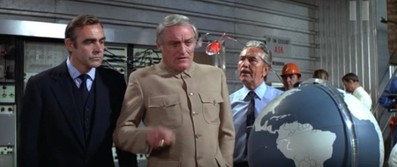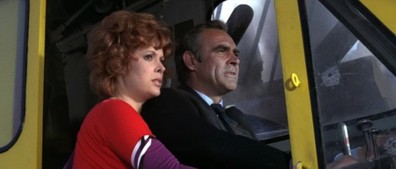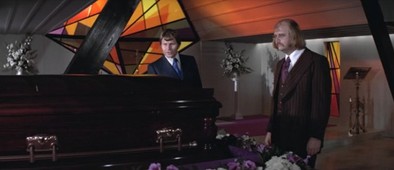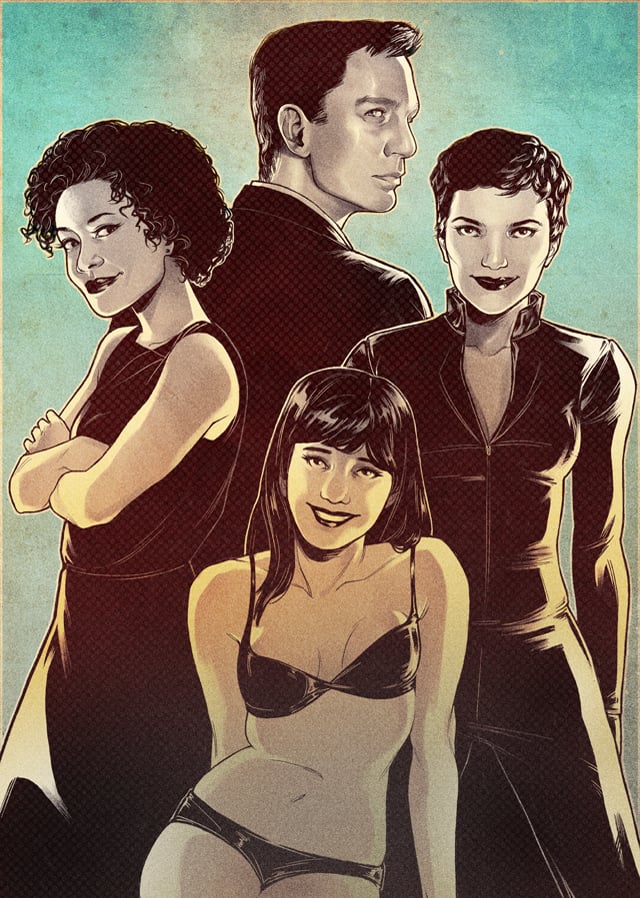
Original illustration by Emilie Majarian for The Mary Sue.
Welcome to Bond Girl, a new series where we’ll be re-watching and re-evaluating every James Bond film until Spectre’s release. Check out previous entries here.
Content warnings for mentions of perceived racism, sexism, domestic abuse/violence towards women, and ableist insults.
I’m going to miss Sean Connery’s Bond showing up in the Eon Production films, but Diamonds Are Forever is basically the best movie on which to send him out. It exemplifies all the good and bad about Connery’s Bond films and the franchise as a whole. I definitely lost track of how many times I watched the film, but it was definitely worth it.
Diamonds Are Forever is the seventh film in the franchise and Sean Connery’s sixth showing in the role of James Bond. The film focuses on Bond’s attempts at sniffing out and then stopping a diamond smuggling ring that is connected to Blofeld and SPECTRE. It’s up to Bond to stop Blofeld from using the smuggled diamonds in the creation of a massive laser set to destroy major cities in the world. It’s the kind of over-the-top, cartoonish plot that should seem ridiculous, but it works for me.

Which is weird, because it shouldn’t work for me. This movie follows Lazenby’s first and only film, and should revolve around Bond’s tireless hunt for Blofeld as the man who killed his wife. It… doesn’t actually do that. Fleming wrote the Blofeld saga (complete with Tracy’s death) as a trilogy, and since the movies weren’t done in the order that he wrote them, we lose that coherency to the narrative.
Instead of him hunting Blofeld down to enact his revenge, Bond is just… looking for him. We’re never told why onscreen, but it’s all good because eventually, Bond finds his man. He also winds up hip deep in the struggle to shut down a smuggling ring out of South Africa. What’s weird and interesting about Diamonds Are Forever is that for a huge chunk of the movie, James Bond isn’t James Bond.
Instead, Bond spends most of the movie undercover as smuggler Peter Franks, in order to make contact with the smuggling ring. Bond even kills the actual Franks and plants ID on him that makes him out to be James Bond. He’s super dedicated to his cover and only in the brief moments when he’s with frequent ally and CIA operative Felix Leiter does Bond come out of the role.

It is as Franks that Bond sees our first official Bond girl in the film, Tiffany Case. Tiffany Case is a hilarious character to me. She’s this bold, brassy redhead and you can tell that, from the start, that Bond likes her. I like Tiffany too; she’s a really fun character, and she seems completely comfortable with her role as a smuggler. There is no feeling (in the film, at least) that Case has been forced into this criminal life.
I don’t know what it is about these awesome redheads, but I am such a fan of how SPECTRE tends to hire them for nefarious tasks. (I’m less of a fan of how these redheads tend not to survive to the end of the film, but okay, SPECTRE sucking is kind of their thing.) Thankfully, Tiffany doesn’t meet a horrible end the way that several of our previous red-haired Bond girls have.
The back-and-forth banter between Bond and Tiffany is actually fun for most of the movie (until the end where things start getting mad misogynistic with his asides, ugh). Case is the reason that Bond gets the plot device necessary to stop Blofeld’s satellite laser beam; she gives him cover during the fight scene on the oil rig; heck, at the end of the film, she’s responsible for uncovering a bomb hidden in a big thing of Baked Alaska. Despite the way that the film tries to treat her like a joke especially near the end, I can think of at least two separate occasions where Case’s actions saved Bond’s bacon.
The movie would’ve been a lot shorter without her, that’s for sure.

I also have some intense feelings about the Blofeld and SPECTRE saga. One of the reasons why this film is a really good wrap-up for Connery’s Bond is that the film also ties up one of the most intense arcs of the series. After the death of Tracy Bond in the previous film, Bond and Blofeld are supposed to be at each other’s throats. This is the final confrontation, with it tacitly set up so that only one of them can survive.
From the second they made Blofeld the overarching bad guy in the film, we knew that this was going to be it. I like Blofeld as far as villains go (not enough to empathize with him, but enough to want to see more of him), but I was glad to see him go out with Connery’s Bond – it’s a fitting conclusion to his era of the Bond saga. Instead of getting another actor change and having someone else wrap up the saga, Connery comes in and gets to be the suave and slick Bond one last time for Eon, finishing MI6’s mission towards SPECTRE in the role he originated. Blofeld is dead at the end and SPECTRE no longer has its head, taking them out of commission for the next forty years.
How awesome is this timing?
We get to watch James Bond have fun whacking the heck out of Blofeld in his bathosphere until the control room is destroyed and – as the film implies – Blofeld is killed in the chaos. It’s a dramatic end to a dramatic villain, and the best part about it is seeing the look of smug satisfaction on Bond’s face once he succeeds.
But despite liking most of the movie, there are a few things that got on my last nerve about the plot. Let’s start with our secondary baddies: after Blofeld, the villains you see the most of are a pair of killers called Mr. Kidd and Mr. Wint. These two men are recurring characters throughout the movie, and you see plenty of them.
Unfortunately, I can’t stand either of them. They’re prone to plodding dialog that’s supposed to be “quippy” and are generally creepy as heck. Seriously, every scene they were in was a major pain. When I say that their dialogue was plodding, I mean that the quip-heavy commentary that works when our Bond actors deliver them just falls flat when the Wint/Kidd duo do it.

Look at this bit of dialogue from after Mr. Wint and Mr. Kidd seal Bond into a coffin and roll it into the crematorium:
Mr. Wint: Very…moving.
Mr. Kidd: Heartwarming, Mr. Wint.
Mr. Wint: A glowing tribute, Mr. Kidd!
That’s not actually funny. It’s just awkward. And since they’re in half of the film’s major scenes, and are in very last scene where Bond and his girl ride off into the sunset on a boat (which is a ridiculous recurring theme that is present in most of the movies I’ve watched so far), we’re plagued with them until the very end. I really could’ve done without Mr. Kidd and Mr. Wint, and they were a definite low point for me in this film.
Of course, Diamonds Are Forever is set in Africa, so you know there’s going to be some problematic representation present. This film isn’t exactly rolling in characters of color, and only one gets anything resembling dialogue. This movie kind of bombs when it comes to racial representation, and it does it in the weirdest way. Most of the people of color in Diamonds Are Forever are background characters with no dialogue; however there are two instances of women of color – specifically Black women – in the film that left me feeling super uncomfortable because of how these women are definitely playing to weird and possibly racialized tropes.

First, there’s a caged Black woman who “turns” into a gorilla in one scene. In the last half of the movie, there’s a scene set in a freakshow setting in a Las Vegas casino. A mad scientist gestures at a tall black woman standing still in the middle of a cage and rattles off so much junk about the process before the woman turns into a gorilla.
She turns into a gorilla.
Okay.
Cool. Cool cool cool.
That’s not something with nasty implications or anything… Nah.
Sure, it’s all bad special effects and a total gimmick in the film, but this is just a bit upsetting considering how Black people of all genders are still compared to monkeys and gorillas. It’s an insult now and I’m sure it was an insult in 1971 when the film first came out. It’s a one-off scene and we don’t ever come back to it, but the image of the caged Black woman turning into an actual animal is just one that left me feeling frustrated.
Following that scene, we don’t see another Black woman until later on in the film: Trina Parks, playing Thumper, the only Black woman in Diamonds to get any lines of dialogue (not that her dialogue is particularly amazing, but okay…). She comes in near the final scenes in Las Vegas, right before they figure out the SPECTRE connection and Blofeld’s base of operations isn’t anywhere in the city.
James Bond heads up to billionaire Willard Whyte’s home and winds up being taken out by two of Blofeld’s henchwomen, Park’s Thumper being one of them. This time, the animal connection is implicit rather than explicit: Thumper shows up after Lola Larson’s Bambi, lounging on a rock like a lioness. Honestly, she reminds me of an old-school version of DC Comics’ Vixen, and that’s not a bad thing. What is a bad thing is that she’s about it in this film. She gets fight related dialogue and sure, she’s really good about kicking Bond’s butt for much of her scene, but I can’t get over how limited parts were for women of color in the Bond franchise.
I also have major issues with how the female characters are portrayed in the film overall. As much as I liked Tiffany Case and Lana Wood’s Plenty O’Toole, they weren’t exactly treated well. None of the women in the film are treated very well. Let’s be very real here: The first woman we see in the film (Mariemin the pre-credits scene) winds up assaulted by James Bond, who takes her bikini top off and proceeds to strangle her with it until she gives up Blofeld’s whereabouts, all while making pithy comments like “I can’t hear you” and “Speak louder.” That sort of thing sets a precedent, and it’s not a very nice one.
I like Case (due in part to my redhead thing, but also because she has wonderful comebacks and a great take-charge attitude), but there’s no denying that she doesn’t exactly get the red carpet treatment. Not only does she get kidnapped and smacked around by Bond during the last couple of Las Vegas scenes, but there’s a point where the men onscreen largely talk about her with derogatory language all linked to her gender and her intelligence. The shift in her character from someone capable of the coldness necessary to hide a body and smuggle diamonds to someone that barely knows which way the business end of a gun is comes as a shock.

Then there’s Plenty O’Toole. Her name is a ridiculous sexual innuendo, she’s framed as a gold-digger, thrown out of a window, and then killed for no reason other than being in the wrong place at the wrong time. And of course she’s needlessly sexualized the entire time. Even in death, the camera lingers on her curves as the most important parts of her.
Ew much?
It’s not enough that Plenty has to die to give Tiffany a much needed wakeup call about how close she’s come to death. No, the camera has to drift over her barely-dressed body as it floats underwater in a way that sexualizes her even in death. It’s skeevy in a way that previous Bond girl deaths (as few as they have been) haven’t been, and hard to keep from fast-forwarding through in later rewatches.
This is my last movie before I get started on Roger Moore’s Bond films, so I’m still a bit warm and fuzzy about my feelings toward Sean Connery. This is a quintessential Connery film and, I mean, he really owned the role. I like it a bit less after a week of watching it than I did when I started, but aside from that brief dip where I was sitting on the edge of my seat and waiting for Lazenby and Niven as breaks in the Connery-rut, I liked his James Bond. I could absolutely do without the constant misogyny and all but… I’m actually going to miss watching him every week. At least I get to look forward to seeing Connery as Bond in 1983’s Never Say Never Again in a few weeks, and I’ll have Roger Moore to keep my attention for a huge chunk of that time.
What I’m looking forward to:
Roger Moore. I mean, I’m not romanticizing his role in the films or anything like that, but I have this issue where I kind of only remember Roger Moore as an adorable elderly man. So I have these memories of him as Bond, only he’s the age he is right now and that’s all kinds of weird.
Specifically, I’m actually really looking forward to rewatching Live And Let Die because of Jane Seymour’s role as the tarot card-reading Solitaire. I’ve got fond and not-so fond memories of the bad guys in this movie too and that’s going to be fun to write about. Expect a few paragraphs on how this movie pulls heavily from the blaxploitation film era/genre and my issues with the portrayal of Caribbean religion (namely the use of a loa like Baron Samedi) coming up next week.
Stitch writes about comics, nerd history, and ridiculous romance novels when not working frantically on her first collection of short stories. Find her on her blog or on Twitter.
—Please make note of The Mary Sue’s general comment policy.—
Do you follow The Mary Sue on Twitter, Facebook, Tumblr, Pinterest, & Google +?









Published: May 25, 2015 08:00 pm